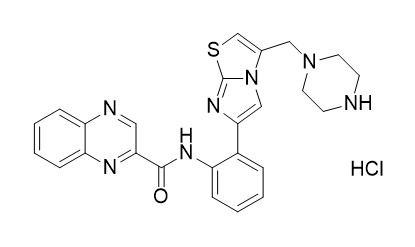SRT1720 HCl
SRT1720 HCl is a selective SIRT1 activator with EC50 of 0.16 μM in a cell-free assay, but is >230-fold less potent for SIRT2 and SIRT3. SRT1720 induces autophagy.
Inquire / Order:
manager@chemfaces.com
Technical Inquiries:
service@chemfaces.com
Tel:
+86-27-84237783
Fax:
+86-27-84254680
Address:
1 Building, No. 83, CheCheng Rd., Wuhan Economic and Technological Development Zone, Wuhan, Hubei 430056, PRC
Providing storage is as stated on the product vial and the vial is kept tightly sealed, the product can be stored for up to
24 months(2-8C).
Wherever possible, you should prepare and use solutions on the same day. However, if you need to make up stock solutions in advance, we recommend that you store the solution as aliquots in tightly sealed vials at -20C. Generally, these will be useable for up to two weeks. Before use, and prior to opening the vial we recommend that you allow your product to equilibrate to room temperature for at least 1 hour.
Need more advice on solubility, usage and handling? Please email to: service@chemfaces.com
The packaging of the product may have turned upside down during transportation, resulting in the natural compounds adhering to the neck or cap of the vial. take the vial out of its packaging and gently shake to let the compounds fall to the bottom of the vial. for liquid products, centrifuge at 200-500 RPM to gather the liquid at the bottom of the vial. try to avoid loss or contamination during handling.
Molecules.2019, 24(6):E1177
Food Bioscience2023, 52:102412
LWT2024, 200:116184.
Plant Methods.2017, 13:108
Biomed Pharmacother.2022, 145:112474.
Food Funct.2024, 15(8):4262-4275.
Kor. J. Pharmacogn.2016, 47(1):62-72
ARPN Journal of Eng.& Applied Sci.2016, 2199-2204
Foods.2023, 12(7):1355.
J Agric Food Chem.2020, 68(43):12164-12172.
Related and Featured Products
Nature, 2007 Nov 29;450(7170):712-6.
Small molecule activators of SIRT1 as therapeutics for the treatment of type 2 diabetes.[Pubmed:
18046409]
Calorie restriction extends lifespan and produces a metabolic profile desirable for treating diseases of ageing such as type 2 diabetes. SIRT1, an NAD+-dependent deacetylase, is a principal modulator of pathways downstream of calorie restriction that produce beneficial effects on glucose homeostasis and insulin sensitivity. Resveratrol, a polyphenolic SIRT1 activator, mimics the anti-ageing effects of calorie restriction in lower organisms and in mice fed a high-fat diet ameliorates insulin resistance, increases mitochondrial content, and prolongs survival.
METHODS AND RESULTS:
Here we describe the identification and characterization of small molecule activators of SIRT1 that are structurally unrelated to, and 1,000-fold more potent than, resveratrol. These compounds bind to the SIRT1 enzyme-peptide substrate complex at an allosteric site amino-terminal to the catalytic domain and lower the Michaelis constant for acetylated substrates. In diet-induced obese and genetically obese mice, these compounds improve insulin sensitivity, lower plasma glucose, and increase mitochondrial capacity. In Zucker fa/fa rats, hyperinsulinaemic-euglycaemic clamp studies demonstrate that SIRT1 activators improve whole-body glucose homeostasis and insulin sensitivity in adipose tissue, skeletal muscle and liver.
CONCLUSIONS:
Thus, SIRT1 activation is a promising new therapeutic approach for treating diseases of ageing such as type 2 diabetes.
Br J Haematol, 2011 Dec;155(5):588-98.
Preclinical evaluation of a novel SIRT1 modulator SRT1720 in multiple myeloma cells.[Pubmed:
21950728]
Cell lines:Human vascular endothelial cells (HUVECs)
Concentrations: 5 μM
Incubation Time: 2 hours
Method:
Transwell Insert Assays are utilized to measure migration. In vitro angiogenesis is assessed by Matrigel capillary-like tube structure formation assay. For endothelial tube formation assay, human vascular endothelial cells (HUVECs) are obtained from Clonetics and maintained in endothelial cell growth medium-2 containing 5% FBS. After three passages, HUVEC cell viability is measured with the trypan blue exclusion assay, and <5% of cell death is observed with SRT1720 treatment.
Nature,2007 Nov 29;450(7170):712-6.
Small molecule activators of SIRT1 as therapeutics for the treatment of type 2 diabetes.[Pubmed:
18046409]
Animal Models: Chase-SCID mice with MM.1S cells
Formulation: 200 mg/kg
Administration:Orally
(Only for Reference)



